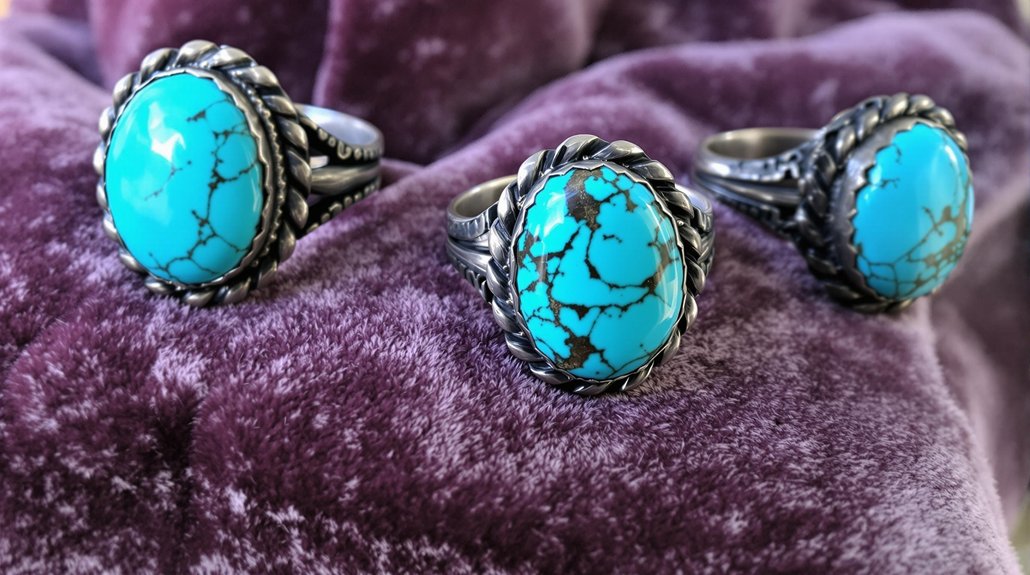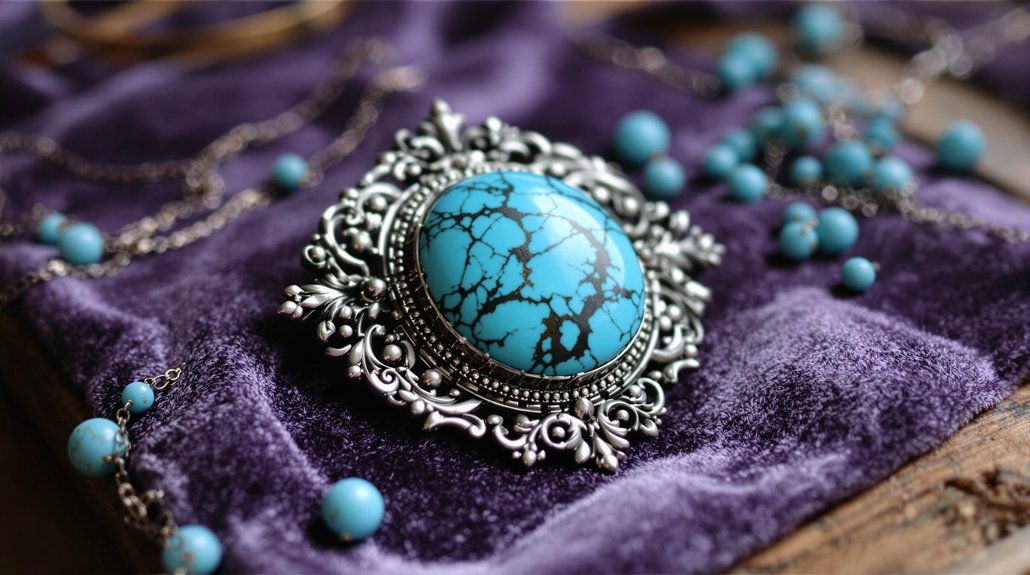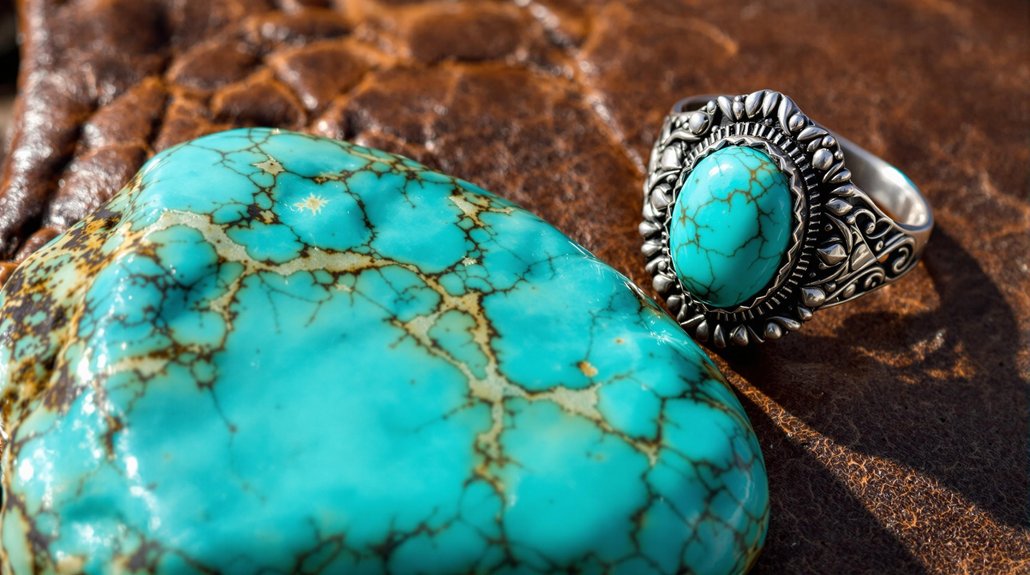Article Contents
- 1 Main Highlights
- 2 The Ancient Origins of Turquoise
- 3 Becoming December’s Official Birthstone
- 4 Victorian Era Turquoise Collections
- 5 Native American Design Heritage
- 6 Caring for Vintage Turquoise Pieces
- 7 Identifying Authentic Vintage Turquoise
- 8 Modern Revival of Antique Styles
- 9 Frequently Asked Questions
- 9.1 Does Turquoise Change Color When Exposed to Different Temperatures?
- 9.2 Can Vintage Turquoise Jewelry Be Worn While Swimming?
- 9.3 Why Do Some Turquoise Pieces Develop Dark Spots Over Time?
- 9.4 Are There Fake Vintage Turquoise Pieces Made Before 1950?
- 9.5 How Does Natural Aging Affect Turquoise’s Market Value?
- 10 Our Final Thoughts
Turquoise’s designation as December’s birthstone in 1912 transformed this ancient gem from a royal and spiritual talisman into a cherished winter favorite. The stone’s rich history spans from Egyptian pharaohs to Native American artisans, with vintage pieces particularly showcasing exceptional craftsmanship through techniques like tufa casting and overlay. Victorian-era collections enhanced turquoise’s status, while traditional Native American designs infused it with sacred symbolism and sophisticated silverwork.
Today’s collectors prize authentic vintage turquoise for its historical significance, cultural heritage, and unique patina. The story of this unexpected birthstone unfolds through centuries of artistic evolution and royal connections.
Main Highlights
- Turquoise replaced bloodstone as December’s birthstone in 1912, marking a significant shift in traditional birthstone associations.
- Ancient cultures valued turquoise for its prophylactic properties, believing the stone would change color to warn wearers of danger.
- Victorian-era turquoise jewelry collections demonstrate sophisticated craftsmanship and design, especially in prestigious locations like Blair Castle.
- Vintage turquoise pieces require specific care, including storage in cool, dark spaces and cleaning with soft, lint-free cloths.
- Contemporary luxury brands are reviving vintage turquoise styles, blending traditional aesthetics with modern design sensibilities.
The Ancient Origins of Turquoise
While many gemstones have rich histories, turquoise stands among the oldest known stones used by humanity, with its origins traced back to around 3000 BCE in Ancient Egypt. The ancient mining of this enchanting gem began in the Maghara Wadi mines of the Sinai Peninsula, where Egyptian artisans initially uncovered its mesmerizing blue-green hues.
The story of turquoise trade spans continents and civilizations, connecting ancient cultures through a network of merchants and adventurers. From the bustling markets of the Ottoman Empire to the sacred temples of Mesoamerica, turquoise earned its reputation as a stone of distinction. Known as “mfkzt” in Egyptian hieroglyphics and “chalchihuitl” to the Aztecs, this precious gem carried different names but universal appeal. The Iranians originally called it pērōzah, meaning victory, before Arab traders adopted their own variation of the name. Chinese artisans demonstrated their reverence for this precious stone through intricate carvings dating back three millennia.
In both Egyptian and Mesoamerican societies, turquoise transcended mere decoration. The stone adorned royal jewelry, ceremonial objects, and religious artifacts, often associated with powerful deities like the Egyptian goddess Hathor.
Its prophylactic qualities were widely celebrated, with many believing the stone could change color to warn its wearer of impending danger or illness.
Becoming December’s Official Birthstone
The elevation of turquoise to December’s official birthstone status marked a significant milestone in the gem’s already illustrious history. In 1912, the American National Association of Jewelers formalized this designation, recognizing turquoise’s historical significance and enduring appeal. This decision transformed December’s gemstone symbolism, replacing the traditional bloodstone with this enchanting blue-green gem. The stone’s proper care requirements make it essential to store pieces in a dry, cool environment to maintain their beauty and integrity. The gem was prized for its robin’s egg blue coloring that made it highly sought after in Persian mines.
| Historical Period | Cultural Value | Symbolic Meaning |
|---|---|---|
| Ancient Egypt | Royal Protection | Divine Power |
| Persian Empire | Sacred Status | Wisdom & Truth |
| Modern Age | Birthstone | Protection & Clarity |
The gem’s passage to official recognition wasn’t merely administrative; it reflected centuries of cultural reverence and artistic appreciation. Coming from the French ‘pierre tourques,’ turquoise earned its place among December’s birthstones through its remarkable versatility and timeless allure. Today, it shares its distinguished status with zircon, blue topaz, and tanzanite, yet maintains its unique position as the most historically significant of the group. Its cool, winter-sky hues and rich cultural heritage continue to make it a cherished choice for those seeking both beauty and meaning in their birthstone jewelry. Turquoise has long been associated with protection and good fortune in many cultures, making it a popular choice for amulets and talismans. Its use in jewelry dates back to ancient times, where it was often paired with other precious gemstones like diamonds, rubies, and precious sapphires to enhance its natural beauty and significance. Even today, turquoise remains a sought-after gemstone for those who appreciate its rich history and spiritual symbolism.
Victorian Era Turquoise Collections
Uncovering Victorian period turquoise collections reveals a fascinating time when this gemstone reached new heights of artistic expression and social significance. The finest examples of Victorian craftsmanship can be found in prestigious locations like Blair Castle, where carefully preserved pieces showcase the period’s devotion to artistic excellence and turquoise symbolism. Each handcrafted piece receives a strong customer rating from collectors and enthusiasts alike.
These collections feature a variety of sophisticated designs, from domed pavé clusters set in bright yellow gold to intricate marquetry patterns combining turquoise with onyx, coral, and ivory. Turquoise pendants were often hung on infants as protective amulets for health and well-being.
The Arts and Crafts movement welcomed turquoise with particular enthusiasm, with renowned designers like Archibald Knox creating distinctive pieces for Liberty & Co and Murrle Bennett & Co.
Today’s collectors can investigate these historical treasures through numerous venues, including museum exhibitions and specialized online marketplaces. Each piece tells a story of meticulous artistry, from gold mesh bracelets adorned with Queen Victoria’s miniature to delicate bar brooches featuring turquoise and pearl combinations.
While some pieces show the characteristic green discoloration that affects this porous gemstone, their historical significance remains undiminished, representing a golden time of jewelry craftsmanship.
Native American Design Heritage
Native American turquoise jewelry tells a rich story through sacred patterns and symbols that have evolved over centuries, with traditional motifs like crescent moons and pomegranate blossoms reflecting both ancient beliefs and Spanish influences.
Each piece’s intricate silverwork showcases the exceptional craftsmanship passed down through generations of Native American artisans, who’ve perfected techniques for creating stunning inlay work and complex designs. Today’s pieces range from simple beaded necklaces to elaborate statement jewelry.
The combination of sterling silver and locally-sourced turquoise creates masterpieces that serve as both cultural artifacts and wearable art, embodying the spiritual significance these pieces hold in Native American traditions. Modern artists like Charles Loloma and Kenneth Begay have pioneered new approaches while honoring these ancestral practices.
Sacred Patterns and Symbols
Sacred patterns and symbols within vintage turquoise jewelry tell compelling stories of three major tribes’ distinct artistic traditions. Each piece carries profound cultural significance, with symbolic meanings that reflect generations of Native American heritage and spirituality.
The Navajo’s bold approach features substantial stones set in sterling silver, with their iconic Squash Blossom necklaces and Concho belts serving as powerful status symbols. Navajo artisans particularly excel at showcasing natural stone variations in their designs. In contrast, Zuni artisans express their creative vision through intricate clusterwork and petit point designs, often incorporating their signature sky-blue Sleeping Beauty turquoise and meaningful animal fetishes. The Santo Domingo Indians pioneered the art of turquoise beadwork, establishing early trade networks near Santa Fe.
The Hopi take a distinctly sophisticated path, eschewing stones altogether in favor of masterful overlay techniques that showcase sterling silver’s versatility. Their designs emphasize spiritual themes through complex metalwork, creating depth and dimension that speaks to their agricultural and natural world connections.
Throughout these traditions, turquoise remains a unifying element, symbolizing strength and wisdom across cultures. Whether adorned with stampwork, clusterwork, or overlay designs, each piece serves as a tangible link to Native American storytelling and spiritual practice.
Traditional Silversmith Techniques
The rich legacy of Native American silversmithing began in the mid-16th century when Spanish settlers introduced metalworking techniques to indigenous craftsmen. The silversmithing evolution transformed from early copper work to sophisticated silver designs, with Atsidi Sani emerging as the initial Navajo silversmith to learn from Mexican artisans. Each piece requires perfect stamp execution or must be completely restarted from the beginning. Early Navajo craftsmen created their pieces using collected silver coins from traders at Fort Defiance.
Traditional craftsmanship in Native American jewelry-making encompasses several distinctive methods that have stood the test of time:
- Tufa casting, utilizing volcanic rock to create one-of-a-kind textured pieces
- Sand casting, enabling intricate designs through carefully prepared molds
- Overlay techniques, perfected by Hopi and Santo Domingo tribes
The mastery of these ancient techniques requires exceptional skill, with artisans heating silver to over 1,700 degrees using traditional tools.
Today’s craftsmen honor these time-tested methods while incorporating contemporary elements. Each piece tells a story of cultural preservation, as these skills are passed down through generations.
The resulting jewelry pieces showcase the remarkable fusion of ancestral wisdom and artistic innovation, making them highly sought after by collectors who appreciate authentic Native American craftsmanship.
Caring for Vintage Turquoise Pieces

Vintage turquoise’s delicate nature demands special attention and care to preserve its beauty and value. As a porous gemstone, it’s susceptible to damage from chemicals, oils, and moisture, making proper cleaning methods vital for collectors who value these timeless pieces. The presence of spider-web matrix patterns in certain vintage pieces makes them particularly valuable to collectors and worthy of extra protection.
| Care Aspect | Do’s | Don’ts |
|---|---|---|
| Cleaning | Soft, lint-free cloth | Ultrasonic cleaners |
| Storage | Cool, dark spaces | Direct sunlight |
| Maintenance | Regular inspections | Chemical exposure |
To maintain these prized pieces, connoisseurs should adopt specific storage solutions that protect their investment. A dedicated jewelry box with individual compartments prevents scratching, while anti-tarnish pouches shield pieces from harmful environmental factors. It’s important to clean vintage turquoise after each wearing, using only the gentlest techniques. Immediate care should be given to pieces right after wearing to prevent buildup of oils and dirt.
The most discerning collectors understand that proper care extends beyond basic maintenance. They’ll store their pieces separately, limit their exposure to daily wear, and consult expert jewelers for professional assessments. This careful attention guarantees that these beloved heirlooms retain their allure and can be passed down through generations, carrying their stories and significance forward.
Identifying Authentic Vintage Turquoise
Distinguishing authentic vintage turquoise from modern imitations requires careful examination of both physical characteristics and historical context.
The stone’s inherent softness of 5-6 makes vintage pieces particularly susceptible to wear patterns that can help authenticate their age. In addition, the unique color of turquoise, ranging from sky blue to greenish blue, adds to its appeal and significance in vintage jewelry. Turquoise is also associated with December birthstone symbolism, representing good fortune and success. This makes vintage turquoise pieces not only a beautiful addition to any collection, but also a meaningful one, carrying the timeless essence of the wearer’s birth month. When shopping for vintage turquoise jewelry, it’s important to consider the stone’s fragility and choose pieces with minimal signs of wear. Whether you’re drawn to the rich history and symbolism of turquoise or simply adore its stunning color, vintage turquoise jewelry is a timeless choice that holds deep personal significance. So, whether you’re treating yourself or searching for the perfect gift, consider adding a piece of vintage turquoise jewelry to your collection and discover your birthstone in a whole new way.
True vintage pieces reflect the rich gemstone symbolism cherished by ancient cultures, from Queen Mary’s Persian collection that was later passed down to Princess Margaret.
Modern Revival of Antique Styles

Recent years have witnessed a remarkable revival of antique turquoise styles in high-end jewelry collections, with luxury brands like Cartier, Van Cleef, and Bulgari leading the charge.
These prestigious houses are drawing inspiration from ancient civilizations while introducing contemporary design innovations that speak to today’s sophisticated collectors.
The latest turquoise trends showcase a masterful blend of vintage aesthetics and modern sensibilities. Sterling silver pairings remain a cornerstone of these reimagined designs. Queen Victoria’s influential gifting of turquoise brooches helped establish the gem’s royal status. Designers are reimagining traditional pieces with clean lines and unexpected material combinations, such as pairing turquoise with rose gold or setting it in minimalist designs that appeal to young professionals. These innovative interpretations are breathing new life into turquoise jewelry, making it a versatile option for both casual and formal occasions. While bold statement pieces remain a staple, the integration of turquoise into designs featuring the most popular diamond shapes 2024 allows for a contemporary edge that feels timeless. This seamless blend of classic and cutting-edge ensures turquoise continues to captivate a wide array of fashion enthusiasts.
Celebrity red carpet appearances have further catalyzed this renaissance, bringing antique-inspired turquoise jewelry back into the spotlight.
What’s particularly fascinating is how modern artisans are preserving traditional techniques while introducing fresh perspectives.
They’re creating pieces that honor turquoise’s rich heritage in Native American and Egyptian cultures while meeting contemporary fashion demands.
Despite concerns about depleting mines, high-quality turquoise remains available, allowing designers to continue crafting exceptional pieces that combine historical gravitas with modern sophistication.
This revival has positioned turquoise as both a collectible investment and a statement of refined taste.
Frequently Asked Questions
Does Turquoise Change Color When Exposed to Different Temperatures?
Turquoise doesn’t change color with temperature variations due to its strong color stability. While extreme temperatures can cause long-term degradation, day-to-day temperature effects won’t alter its signature blue-green appearance.
Can Vintage Turquoise Jewelry Be Worn While Swimming?
Swimming with vintage turquoise jewelry isn’t recommended. Following proper jewelry care precautions is crucial, as water exposure can weaken settings, damage the stone, and diminish the piece’s historical value.
Why Do Some Turquoise Pieces Develop Dark Spots Over Time?
While proper turquoise preservation techniques can help, dark spots commonly develop when this beloved stone absorbs oils and chemicals through its porous surface. Body oils and moisture are frequent culprits.
Are There Fake Vintage Turquoise Pieces Made Before 1950?
Yes, there’s a significant amount of fake turquoise from pre-1950. Due to minimal regulation and high demand, fraudulent pieces were produced using synthetic materials and de
How Does Natural Aging Affect Turquoise’s Market Value?
Natural aging improves turquoise’s market value, as collectors prize the natural patina and deeper colors. Market demand rises for well-aged pieces, especially those showing authentic wear from decades of proper care.
Our Final Thoughts
Like a desert stream that reveals its riches over time, turquoise’s expedition from ancient amulet to December’s cherished birthstone reflects humanity’s enduring love affair with this mystical gem. Today’s collectors aren’t just preserving pieces of jewelry; they’re safeguarding a legacy that spans civilizations and cultures. As vintage turquoise experiences its modern renaissance, it’s clear this celestial blue stone hasn’t just survived time – it’s transcended it.

